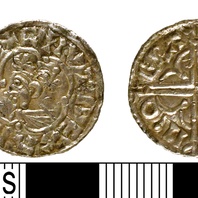
Viking Objects
Coin of Cnut the Great (NARC-5DBF29)
This silver penny was minted in Cambridge for King Cnut the Great, the Danish king who reigned over England from 1016-1035. This particualr coin is is classified as a quatrefoil obverse type. Minting coins was a way of controlling the means of exchange within a kingdom and which created a more easily administered standardized system of trade. Moreover, the coins themselves were often used as propaganda, portaying symbols and statements that gave off a desired message. The Vikings later used the minting of coins to legitimize their own rule.
Read More
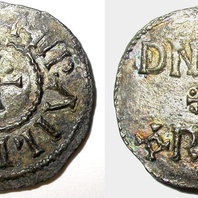
Viking Objects
Viking York Penny (1995-17)
This silver penny was found during demolition work at St Alkmund’s Church in 1967. This type was minted at York for the rulers Sigeferth and Cnut, but this coin has no names, whether of a ruler, a moneyer or a mint. Sigeferth is recorded as being a pirate in Northumbria around 893 and seems to have assumed control after Guthfrith’s death in 895. Cnut is not attested in written sources but Scandinavian tradition places him in Northumbria around the same time. The joint Sigeferth Cnut coins and the sole issues of Cnut were minted around c. 900. This type of penny is known as Mirabilia Fecit from the Latin Cantate Dominum canticum novum, quia mirabilia fecit. Mirabilia fecit means ‘he made it marvellously’ and is the inscription on one side of the coin while the other has the inscription DNS DS REX (‘Dominus Deus rex’ = ‘the lord God almighty is king’).
Read More
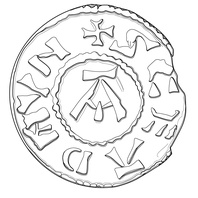
Viking Designs
Drawing of a St Edmund Penny
Between 895 and 915, Scandinavian settlers in East Anglia minted a series of pennies and half pennies with the inscription SCE EADMVND REX (St Edmund the king). These coins appear to have been used widely throughout the Danelaw, and a large number of them were discovered in the Cuerdale Hoard from Lancashire.
Read More
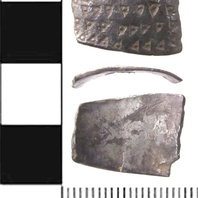
Viking Objects
Silver Arm Ring Fragment (SWYOR-58AFB4)
A fragment of an Early Medieval silver decorated arm ring with triangular punches each with a pellet in the centre. The object may represent hacksilver, but as it is broken rather than cut, this is not certain. Nonetheless, arm rings functioned as both a means of storing wealth as well as putting the wealth and status of the individual on display.
Read More
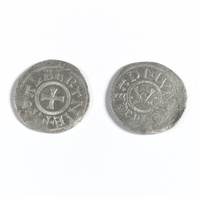
Viking Objects
Reproduction Viking Silver Penny
This reproduction of a Viking silver penny immitates those minited bu the Vikign rulers of York in the tenth century. Viking rulers in the Danelaw eventually took up the Anglo-Saxon practice of minting coins which helped legitimise their authority.
Read More
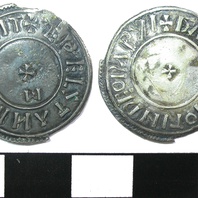
Viking Objects
Silver Penny (1914/543-1)
This silver penny of King Aethelstan, who was King of England from 927-939, was minted in Derby by the moneyer Gadierd between 937-939. It is not known where it was found. Moneyers were people who were permitted to mint money on behalf of the king. Minting coins was a way of controlling the means of exchange within a kingdom and which created a more easily administered standardized system of trade. Moreover, the coins themselves were often used as propaganda, portaying symbols and statements that gave off a desired message. The Vikings later used the minting of coins to legitimize their own rule.
Read More

Viking Objects
Coin of Cnut the Great (NARC-9AE391)
This silver Helmet IIIc Type penny was minted for King Cnut of England by the moneyer Eadwine in Thetford. The obverse displays + CNUT RECXA with a figure wearing a pointed helmet. The reverse displays + EDPINE ON DEOD and a voided short cross. Minting coins was a way of controlling the means of exchange within a kingdom and which created a more easily administered standardized system of trade. Moreover, the coins themselves were often used as propaganda, portaying symbols and statements that gave off a desired message. The Vikings later used the minting of coins to legitimize their own rule.
Read More
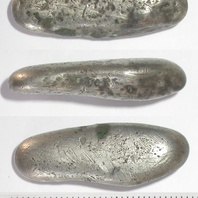
Viking Objects
Silver Ingot (DENO-CE6103)
This silver ingot was made by melting down worked silver and casting it in an open mould. The Vikings arriving in England had a bullion economy in which they paid for goods with silver that was weighed to an amount agreed between the buyer and the seller. Hacksilver and silver ingots are the most common evidence for their bullion economy. It took some time for the Scandinavian settlers to adopt a monetary economy like that of the Anglo-Saxons, and both systems were used simultaneously for a while before they fully adopted the new system. The Vikings were familiar with monetary economies but they treated coins as just another form of silver before adoption of a monetary economy.
Read More
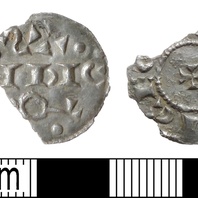
Viking Objects
Viking Silver Penny (DENO-7A0AF7)
An incomplete silver early medieval penny of the Vikings possibly minted in the name of Sihtric and imitating swordless St Peter Two-Line Type coins which were minted in York, c.905-920. Sihtric Caoch was the Scandinavian ruler of Dublin from 917-920 CE and subsequently the ruler of Northumbria from 921-927 CE. It is not certain why he left Ireland. The Irish annals state that it was ‘through the grace of God’ and do not elaborate on the politics behind his departure. After the establishment of the Danelaw, some Viking leaders decided to mint their own coins to solidify their legitimacy in the eyes of the local populace. This created a hybrid economy where some members of the Danelaw used bullion and others used coins.
Read More
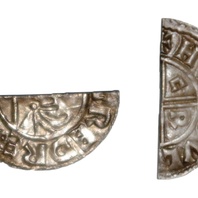
Viking Objects
Aethelred II Penny (LIN-8887C3)
A cut CRUX-type penny minted by Hundulf of York on behalf of King Aethelred II. While this coin is Anglo-Saxon, the fact that it has been cut may suggest that it was used as a part of a bullion transaction in line with the dual bullion-monetary economy established by the Vikings in England.
Read More
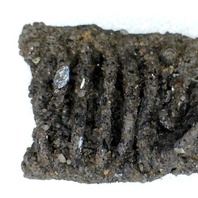
Viking Objects
Silver Wire Embroidery (1988/225-16)
This silver wire was found in Mound 11 at Heath Wood, Ingleby, Derbyshire. This burial mound contained fragments of the remains of an adult human together with the cremated remains of animals, including a small dog, a horse and sheep. The burial was accompanied by this silver wire, an iron spade shoe, some small iron nails and some corroded metalwork. The silver wire was found in two parts with traces of carbonised fibres attached. This suggests that it was probably attached to a piece of cloth. Silver and gold embroidery are known from a number of Viking Age graves, including from nearby Repton, Derbyshire, as well as further afield, e.g. Birka, Sweden. At Birka, wire embroidery was found on caps and headbands, although there is no reason to think that it was only used on headgear at all times.
